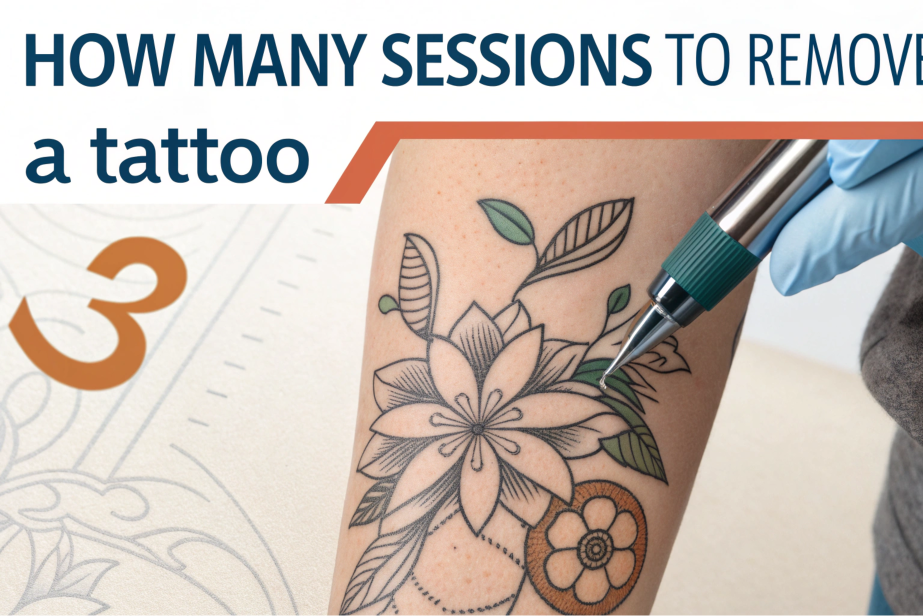How Many Sessions to Remove a Tattoo? Factors & Tips

1. Introduction
Tattoos are personal works of art, but sometimes, they outlive their significance. Whether it’s a name you’d rather forget or an outdated design, tattoo removal offers a second chance to reclaim your skin.
But one question looms large for anyone considering this procedure: how many sessions will it take to remove my tattoo?
Understanding the number of sessions required is essential for planning your time, budget, and expectations. Factors like tattoo size, color, placement, and even your skin type all play a role.
2. Factors That Affect the Number of Tattoo Removal Sessions
2.1. Tattoo Size and Placement
The size of your tattoo is one of the most obvious factors. Larger tattoos naturally require more laser coverage and, therefore, more sessions. For instance:
- A small finger tattoo might take 6-8 sessions.
- A full sleeve tattoo could take 10-15 sessions or more.
Placement also matters. Tattoos on areas with good blood circulation, like the chest or arms, tend to fade faster than those on extremities like the ankles or feet. Think of it like watering a plant—better circulation provides the "nutrients" your immune system needs to break down ink particles.
2.2. Ink Color and Type
Not all ink colors are created equal. Black ink is the easiest to remove because it absorbs all laser wavelengths. On the other hand:
- Green and blue pigments are more stubborn.
- Yellow, white, and fluorescent inks can be nearly impossible to erase completely.
Imagine trying to erase pencil marks versus permanent marker—it’s a similar concept.
2.3. Skin Type
Your skin type, categorized by the Fitzpatrick scale, affects how well the laser works. For example:
- Lighter skin tones (Types I-III) typically respond better to laser treatment.
- Darker skin tones (Types IV-VI) require more sessions to avoid pigmentation issues.
2.4. Age of the Tattoo
Older tattoos are often easier to remove because the ink has already begun to fade naturally. Think of it as a weathered painting—removing it takes less effort than a freshly painted masterpiece.
2.5. Ink Depth and Density
Professional tattoos are often deeply embedded and densely packed with ink, making them harder to remove. In contrast, amateur tattoos are usually lighter and more superficial.
2.6. Laser Technology Used
The type of laser used can significantly impact the number of sessions. Modern lasers like PicoSure or Q-switched lasers are more efficient, breaking down ink particles faster than older technologies.
2.7. Lifestyle and Aftercare
Your immune system plays a critical role in flushing out broken-down ink particles. A healthy lifestyle, including staying hydrated and avoiding smoking, can speed up the process. Proper aftercare, like avoiding direct sunlight and following clinic instructions, also ensures optimal results.
3. Average Number of Sessions for Tattoo Removal
On average, most tattoos require 6-12 sessions to fade significantly or be completely removed. However:
- Small, simple black tattoos may need as few as 4-6 sessions.
- Larger, multi-colored tattoos can take 10-20 sessions or more.
Here’s a quick breakdown in table format:
| Tattoo Type | Average Sessions | Notes |
|---|---|---|
| Small Black Tattoo | 4-6 sessions | Easier to remove due to ink type. |
| Large Black Tattoo | 8-12 sessions | More ink coverage requires more time. |
| Multi-Color Tattoo | 10-20 sessions | Complex colors like green or yellow. |
| Amateur Tattoo | 4-8 sessions | Ink is usually less dense. |
Factors like technology and aftercare can shift these numbers.
4. Why Does Tattoo Removal Take Multiple Sessions?
Laser tattoo removal doesn’t work overnight because the process relies on your body’s immune system. Here’s what happens:
- The laser breaks down the ink particles into smaller fragments.
- Your immune system gradually flushes these fragments out of your body.
- Healing takes time between sessions to avoid skin damage.
Rushing the process can lead to scarring or incomplete removal. Think of it like peeling layers off an onion—slow and steady wins the race.
5. Tips to Minimize the Number of Sessions
- Choose the right clinic: Look for clinics with advanced lasers like PicoSure or Q-switched.
- Boost your immune system: Stay hydrated, eat a balanced diet, and avoid smoking.
- Follow aftercare instructions: Avoid sun exposure, keep the area clean, and use recommended creams.
These steps can help you achieve better results in fewer sessions.
6. FAQs About Tattoo Removal Sessions
Q: How much time between sessions?
A: Most clinics recommend 6-8 weeks to allow proper healing.
Q: Does it hurt?
A: Pain levels vary, but many describe it as a rubber band snapping against the skin. Numbing creams can help.
Q: Can all tattoos be completely removed?
A: Not always. Some colors and inks may leave faint traces.
Q: How much does it cost?
A: Tattoo removal typically costs $200-$500 per session, depending on size and complexity.
7. Conclusion
Tattoo removal is a journey that requires patience, but understanding the factors involved can help set realistic expectations. By choosing the right clinic, following aftercare diligently, and maintaining a healthy lifestyle, you can minimize the number of sessions and achieve the fresh start you’re looking for.